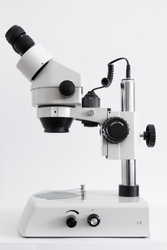LED vs. Halogen: Illuminating the Choice for Your Microscope
27th Dec 2023
Microscopy unlocks a hidden world, revealing the intricate details of the invisible. But to truly appreciate these marvels, proper illumination is key. For decades, halogen bulbs have been the dominant source of light in microscopes. However, the rise of light-emitting diode (LED) technology has challenged this status quo. Both LED and halogen lighting offer distinct advantages and disadvantages, making the "best" choice dependent on individual needs and preferences. Let's delve into the illuminating world of these two lighting solutions to guide you in selecting the optimal option for your microscopy endeavors.
Halogen Lighting: The Familiar Glow
Halogen lamps have been the traditional workhorse of microscopes for many years. They function by passing an electric current through a tungsten filament, causing it to heat up and emit light. This incandescence produces a warm, yellowish-white light similar to sunlight, making it suitable for observing a variety of biological specimens.
Advantages of Halogen Lighting:
- Cost-effective: Halogen bulbs are generally cheaper to purchase compared to their LED counterparts.
- Color rendition: The color spectrum emitted by halogen lamps closely resembles natural light, making it ideal for observing specimens where accurate color representation is crucial.
- Ease of replacement: Replacing a halogen bulb is a simple and straightforward process, often requiring minimal technical expertise.
Disadvantages of Halogen Lighting:
- Short lifespan: Halogen bulbs have a comparatively shorter lifespan than LEDs, typically lasting around 2,000 hours. This translates to more frequent replacements and associated costs.
- Heat generation: Halogen bulbs generate significant heat during operation, which can:
- Damage heat-sensitive specimens: This is particularly concerning for delicate biological samples.
- Reduce comfort during extended use: The heat emanating from the bulb can make prolonged microscopy sessions less comfortable, especially in warm environments.
- Shorten the lifespan of the bulb: The heat generated by the filament can contribute to its deterioration, further reducing its lifespan.
- High energy consumption: Halogen lamps consume more energy than LEDs to produce the same level of brightness, making them less eco-friendly and contributing to higher electricity bills.
LED Lighting: The Rising Star
LEDs are semiconductor devices that convert electrical energy into light. They offer several advantages over traditional halogen bulbs, making them an increasingly popular choice for microscope illumination.
Advantages of LED Lighting:
- Long lifespan: LEDs boast a significantly longer lifespan than halogen bulbs, typically lasting around 60,000 hours. This translates to fewer replacements, lower long-term costs, and reduced environmental impact.
- Energy efficiency: LEDs consume significantly less energy than halogen bulbs to produce the same level of brightness, making them a more eco-friendly and cost-effective option in the long run.
- Minimal heat generation: LEDs operate at a much cooler temperature compared to halogen bulbs, offering several benefits:
- Protects heat-sensitive specimens: The cooler operating temperature minimizes the risk of damage to delicate biological samples.
- Enhances user comfort: The reduced heat emission makes extended microscopy sessions more comfortable for the user.
- Extends lifespan: The cooler operating temperature contributes to a longer lifespan for the LED itself.
- Adjustable intensity and color temperature: Many LED microscopes offer adjustable intensity and color temperature, allowing users to tailor the light to their specific needs and observation requirements. This can be particularly beneficial for fluorescence microscopy or situations where precise color control is critical.
Disadvantages of LED Lighting:
- Higher initial cost: While LEDs offer significant cost savings in the long run due to their exceptional lifespan and energy efficiency, their initial purchase price can be higher compared to halogen bulbs.
- Color rendition: While some newer LED models have addressed this concern, earlier LED technology was sometimes criticized for producing a cooler, slightly blueish light compared to the warmer tone of halogen lamps. However, advancements in LED technology have largely mitigated this issue, and many modern LED microscopes offer excellent color rendition.
Making the Choice: Consider Your Needs
Ultimately, the choice between LED and halogen lighting for your microscope depends on your specific needs and priorities. Here are some key factors to consider:
- Budget: If upfront cost is a major concern, halogen bulbs might be a more suitable choice. However, consider the long-term cost implications of bulb replacements and energy consumption when making your decision.
- Frequency of use: If you use your microscope frequently, the longer lifespan and energy efficiency of LEDs can offer significant cost savings over time.
- Heat sensitivity of samples: If you work with heat-sensitive specimens, LED illumination is the clear winner due to its minimal heat generation.
- Color requirements: If accurate color representation is essential for your work, carefully research the color rendition capabilities of both LED and halogen options in the specific microscope
Contact us today to learn more about how we can help you achieve your healthcare supply chain goals.
(732) 447-1100 // info@cenmed.com

